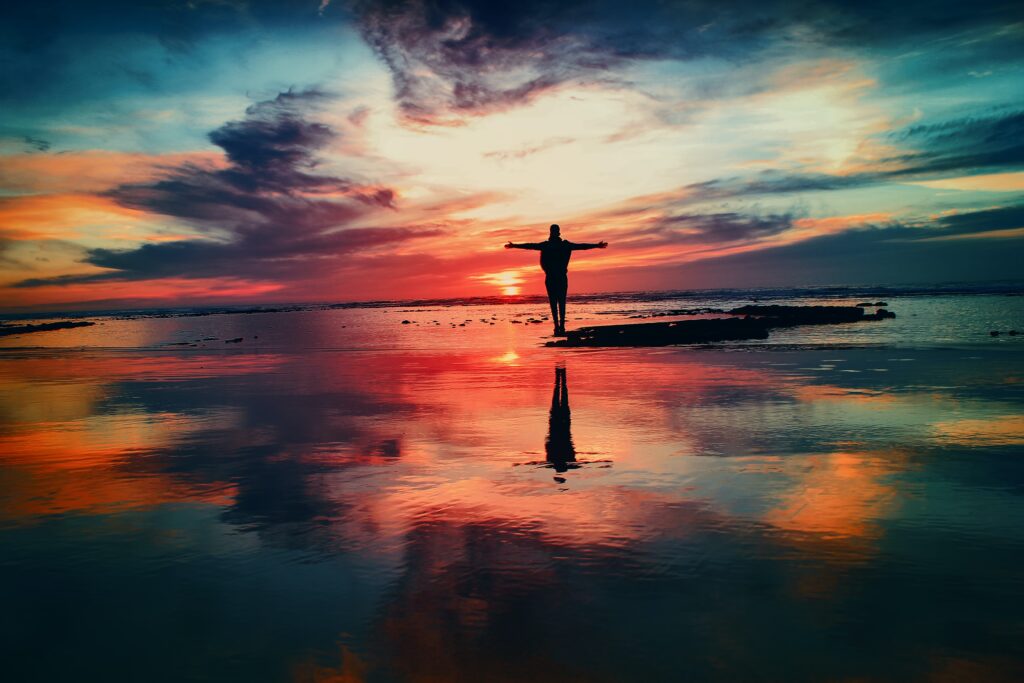You might think yoga is a class you go to a few times a week. But really, it’s not. You might think yoga is a physical fitness regimen that you incorporate into your strength and cardio-based routines. But really, it’s not.
You might think yoga is a physical fitness regimen that you incorporate into your strength and cardio-based routines. But really, it’s not.
You might think yoga is focusing on breath for endless hours (something you find to be incredibly boring and can’t understand why someone would ever *choose* to partake). Or contorting your body into positions that don’t fit your physical self. Or is only for thin, ‘fit-looking’ people… because who can stand those hot rooms, anyway?
But really, it’s none of these things.
Yoga, translated from the Sanskrit (an ancient written language, never spoken) meaning ‘oneness’ or ‘unity,’ is a whole system of being that brings body, mind, and breath together as one. The breath is the tool through which we invite the Life Force (prana) energy into our being; it is connection to the Spirit, or the Divine. But more on that later.
Patanjali, who codified the system of yoga around the time that Christ walked the Earth, drew upon a tradition many thousands of years old that had been passed down from sages, gurus, and yogis. The Yoga Sutras outline the Eight Limbs, or steps, of living a yogic life. Initially practiced by Brahmans, or the priests and monks of the Indus-Sarasvati civilization some 5,000 – 10,000 years ago, it was adapted by yoga masters beginning in the 2nd century CE for people living more ordinary lives. It was then that Classical Yoga transitioned to what we in the West know as Hatha Yoga, from which most forms of Western yoga have descended. Introduced to the U.S. in the late 19th century, yoga then began its journey here, which continues to evolve.
I am Punjabi: yoga’s origins, its movements, run in my blood. While I used to practice yoga in group classes, I found the following problems arise:
- Setting Intention: In order to create an intention, we have to first slow down. I know I was never taught as a child how to connect with my Self. That Centered Self is the place from which you find and set your intention (for your practice, for your day, etc.). If you’re practicing yoga without setting the intention of bringing mind, body, and breath together as one, you’re not actually practicing yoga.
Upon entering these yoga classes, I would be rushed through ‘Om’ chanting and a quick Namaste. Did anyone in the room even understand the purpose behind the mantras? Did they understand the meaning behind bringing their pointer fingers and thumbs together in a circle in gyan mudra (pronounced guy-ah-nah or jah-nah moo-drah)? Pieces of my ancestors’ spiritual practices had been co-opted by these teachers without explanation or homage paid to its origins. As a woman with direct lineage to yoga’s beginnings, it was disheartening, to the say the least; worse yet, it felt colonialist.
- Making My Body Fit into the Pose: Asana Yoga, the fourth limb as described by Patanjali, is the one dimension that I consistently see in Western-style yogas. Asana, meaning ‘pose’ or ‘posture’, derives from poses seen in all beings in nature; it is the natural state of ease and awareness that Asana Yoga aims for. It isn’t about ‘mastering’ all the poses, and it’s certainly not about making your body fit into the pose—something I wish the Western yoga teachers had reminded me of throughout. While practicing Asana Yoga, you find steadiness and naturalness by making the poses work for your body. You can practice Asana Yoga just by sitting in Easy Pose, setting intention, and connecting your body, mind, and breath, which leads me to the third challenge.
- Comparison: In our ultra-competitive, solo bootstrap-pulling culture, I found it absolutely impossible to focus on my own breath, my own awareness, without comparing my body to all other bodies in the room. I remember times when I couldn’t possibly force my body into a position; and even if the teacher was kind enough to remind me that it was ok I couldn’t get there, I was left with a dearth of options, a lack of support, and a feeling of not good enough. Comparing myself with all other bodies around me left me feeling like I could never attain the pinnacle of Asana Yoga.
Letting go of these expectations—about my body, about the poses, and about why I was there—wasn’t something I could do without transitioning to a solo practice. And it was in this solo practice that I discovered the true meaning and beauty of yoga.
Yoga is about devotion: devotion to the Higher Self as devotion to the Spirit. It’s about how we move in relationship to other beings in the world. It’s about connecting to the Divine in all of us. It includes prescription of mental preparations, in addition to physical cleansing and heightened, steady awareness. It is about connecting the mind, body, and breath (the prana, life force) as one. It is about making shifts internally so that we may feel and become those shifts externally.
For those of you who have yet to dip your toe into this yoga thing, I would urge you to get to know some teachers in your area. While they may be authentic to themselves, are they able to hold space for others and guide you through your own practice? Do their words match their energy in the room, and do you feel supported in your journey?
Try to find someone who honors yoga’s lineage and brings forth all the universe’s elements into the room. Yoga practice comes from an energetically spiritual place, not from the physical realm. Find someone who seeks true connection with these spiritual practices of the billions of descendants of the Indus Valley and Vedic civilizations; someone who honors the Rig Veda and the Bhagavad Gita; and someone who incorporates mantras, mudras, and chakras into their yogic practices.
If we’re going to borrow from another culture half a world away, let’s do so with honor and gratitude.
All are welcome into the light.


